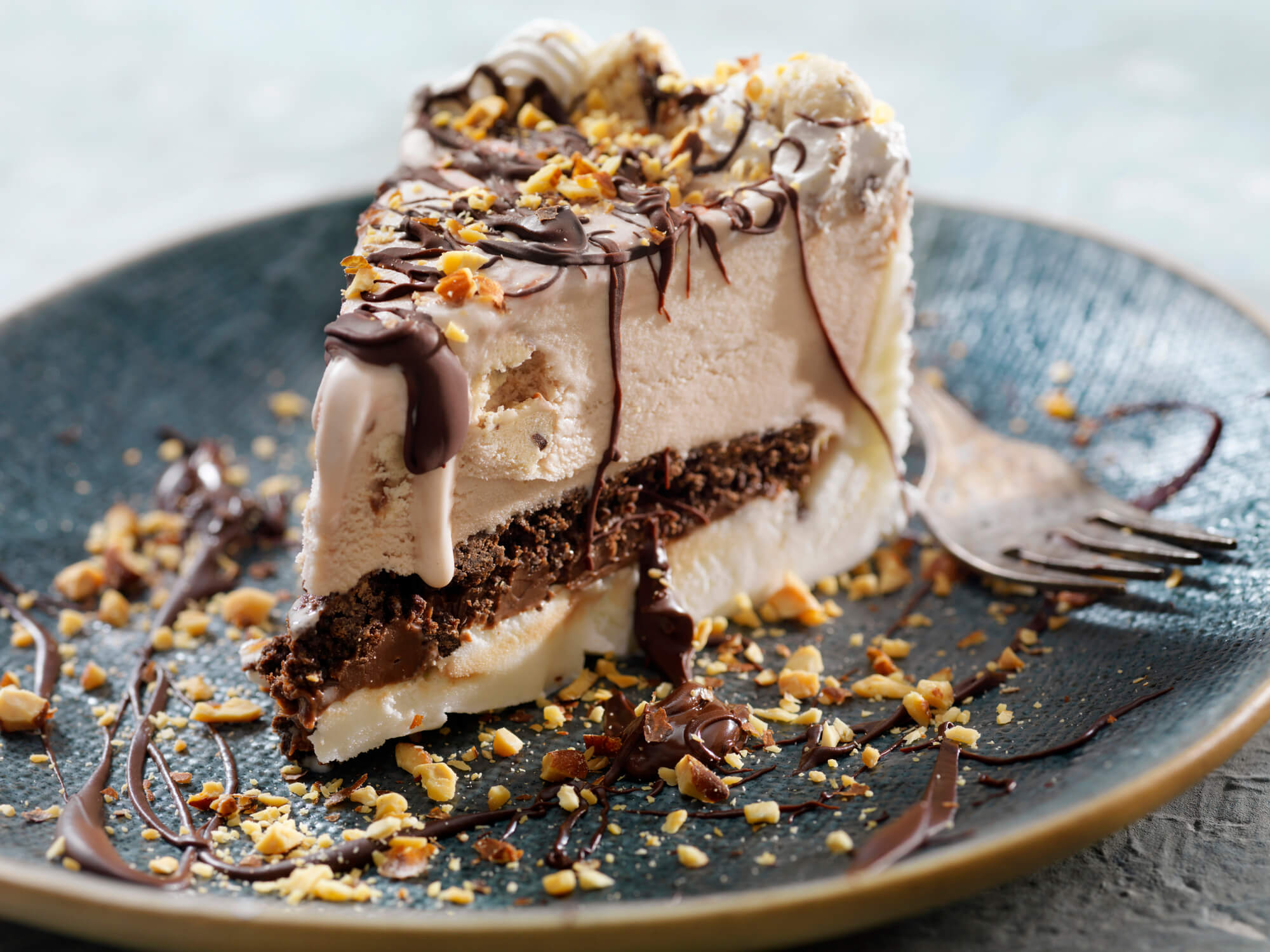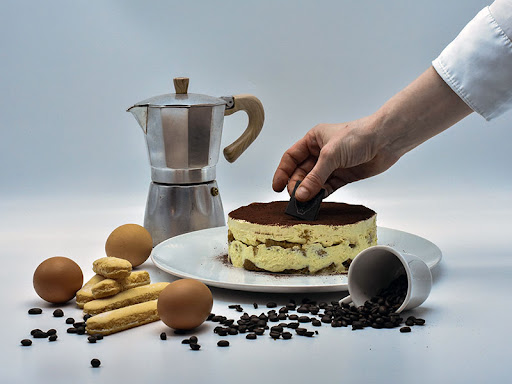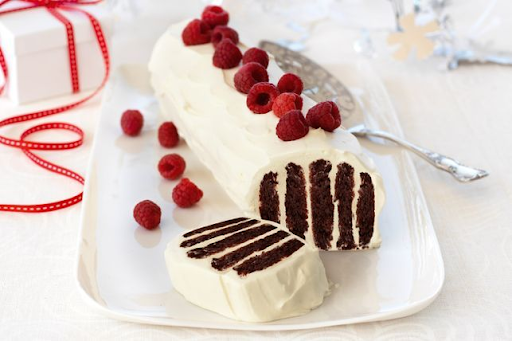Gather ‘Round for Bundt Cakes
Bundt Cakes are commonly attributed as an American invention, something that represents the innovation and ingenuity of the postwar economy of the States. But did you know the history of this round-shaped cake is far older than the founding date of the United States? Let’s find out where the Bundt comes from and how it’s become the legendary cake it is today.
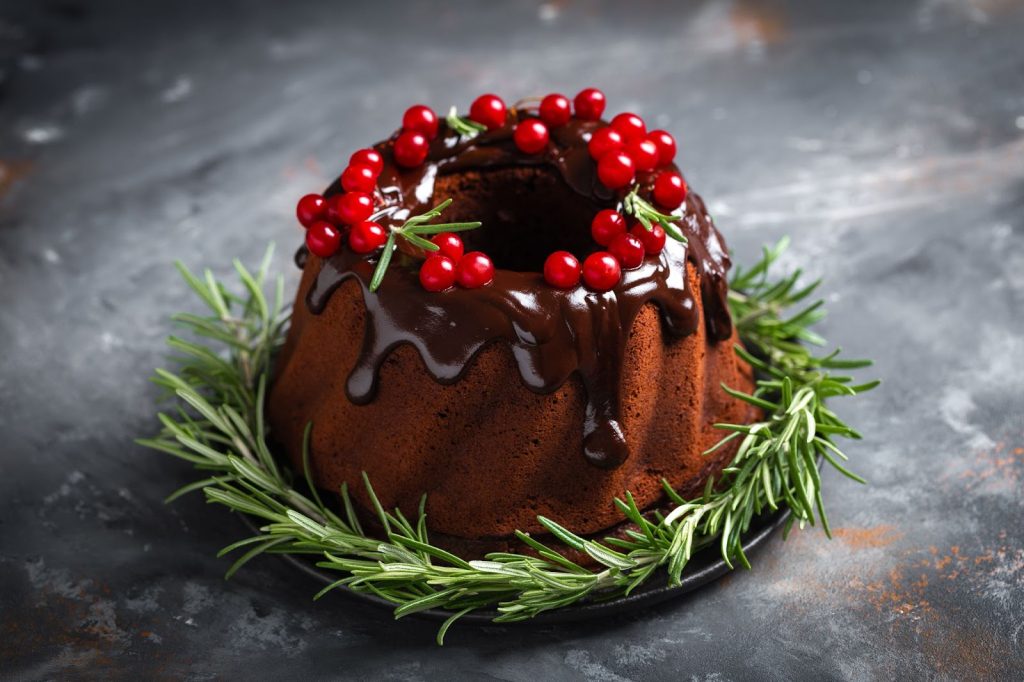
A classically decorated Bundt cake with glaze and fruits
What is a Bundt Cake?
A Bundt cake is a round cake with a large hole in the centre. In some ways, it’s as simple as that, and in others, there’s a whole web of other details to this answer. There’s not really a strictness to the ingredients, toppings, or decor; a bundt cake is really any cake that’s made in a Bundt pan. Similarly to Kleenex or Frigidaire, Bundt pans are what’s called a “generic trademark” or a product that has become deeply associated with the brand name. Thus, many North Americans, call any donut-shaped cake a Bundt.
Even with the very broad definition, there are still some common associations with this cake. Many people appreciate Bundt cakes for how impressive they can look even with the simplest adornments or skill level. Because of this, very simple habits for icing have been adopted, such as a drizzle of glaze or a dusting of icing sugar. Because of their simplicity and history, Bundt cakes are also associated with large gatherings such as holidays or celebrations. For these, bakers will dress-up their cakes with more elaborate decorations such as edible flowers, whole fruits, or whole spices, such as anise or clove.
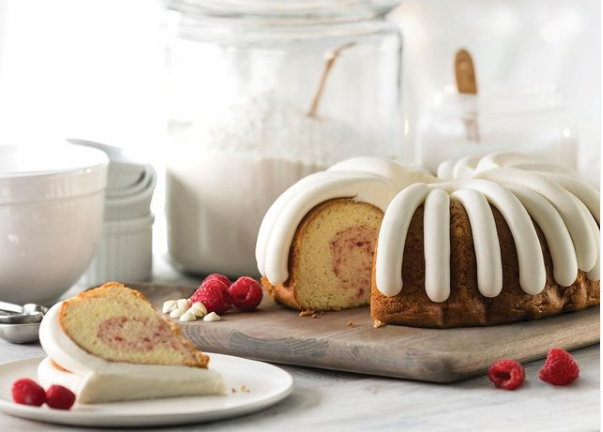
What Made Bundt Cakes So Popular?
For the longest time, this cake was not popular in the United States and Canada. The reason being, there were no commercially available Bundt pans! But things changed in the late 1940s. A few members of a Jewish volunteer organization for women in Minnesota called Hadassah were looking for a way to make an Eastern European dessert called Gugelhupf. If you’re not familiar with this dessert, it’s a round cake with a large hole in the centre. Does that description sound familiar? Now, there are some differences between the Gugelhupt and Bundt cake, which we’ll dive into in a moment, but the Gugelhupf was without a doubt the inspiration for the Bundt pan. In fact, the women, namely Rose Joshua, Fannie Shanfield, and Mary Abrahamson, missed their Gugelhupf so much, that they brought an old pan that one of them had to a cookware company called Nordic Ware to see if it could be recreated.
Henry and Dotty Dalquists were the entrepreneurs of the now very popular Nordic Ware, and they were intrigued by the old ceramic dish and the European cake behind it. With the help of aluminum, they made and trademarked their version of the circular pan. They chose the word “Bundt” in reference to the German word bundkuchen, which means “a cake for a gathering.” The “t” was added for trademarking reasons, as well as to distance any association with the German American Bund, which was an American Nazi group.
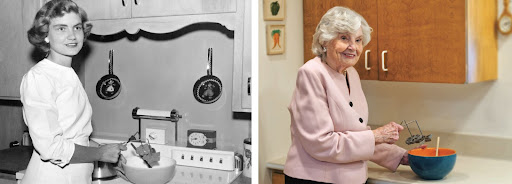
Dotty in 1946 and 2021 (Nordic Ware)
Interestingly, many years later in 1973, when Nordic Ware attempted to trademark a Bundt cake mix, the trademark examiner found previous American instances of Bundt Kuchen cake recipes. Specifically in The Settlement Cookbook published in 1903, the cake was described as made in a Bundt form, and was very similar to a Gugelhupf. This wasn’t enough to say that Nordic Ware knew about this before naming their pan, but it was enough that they were unable to apply their trademark to finished cakes or the cake mix.
Back in the 1940s, Nordic Ware made the pan and waited. Contrary to the success of the pan today, it didn’t take off right away. For many years, most of their customers were from Hadassah fundraising events, or were the organization volunteers’ friends and family. But everything changed in one day at an iconic 1966 Pillsbury Bake-off.
Tunnel of Fudge
The Pillsbury Bake-Off Contest has been held since Pillsbury’s eightieth birthday in 1949. It was created to promote their product, the Pillsbury Best Flour, and promised a hefty grand prize of $25,000. In the 1966 contest, Texan Ella Herlfrich submitted her Tunnel of Fudge Cake and used her Bundt pan to make it. Her original recipe used a now-discontinued product called Pillsbury’s Double Dutch Fudge Buttercream Frosting Mix that gave the cake a mysterious fudge ring throughout its centre. Even though this cake is probably the most popular recipe to come out of the contest and put Bundt cakes on the map, it only won second place that year. Ella won just $5,000 and a tractor. And the world won Bundt pans!
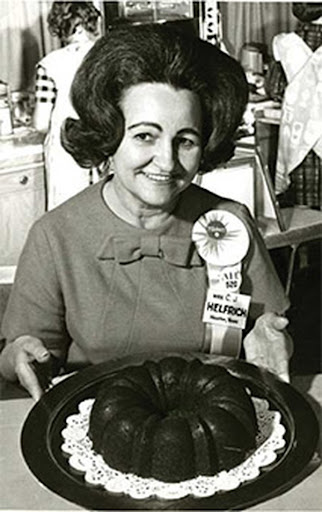
Ella, her legendary Tunnel of Fudge, and her second prize ribbon (Minnesota Alumni)
People were absolutely enchanted with Ella’s recipe and the shape of her cake. Pillsbury received over 200,000 letters inquiring about how to make the cake and how to achieve the unique shape! You can only imagine how Henry and Dotty Dalquists felt, being the only manufacturers of the doughnut-shaped cake pan. In 1972, a special bundt streusel spice cake had taken first place in the Pillsbury Bake-Off Competition. This was accompanied by a whopping eleven other award winners who had also submitted bundt cakes into the annual competition. We must add, it was a general baking contest, not one designed for just the best bundt cake. Twelve winning bundt cakes were significant. This same year, Pillsbury apparently sold $25 million worth of bundt cake mixes. By 2016, more than 70 million bundt pans had been sold by Nordic Ware across North America.
Why do Bundt Cakes Have a Hole?
One of the benefits of baking a cake in a Bundt pan is that the heat distribution makes it an easy cake to bake. Because of the hole in the centre, there is more contact with the heat of the pan. This is especially great for dense cakes like pound cakes because they are prone to uneven baking. You can have browned edges and a battery centre easily with pound batter, whereas a Bundt pan solves this for you. Hence why Bundt recipes are so popular for novice bakers or people in a rush. In Ella’s case, the circular shape of the cake, made her ring of fudge extra special and unique; each piece has it fully surrounded by cake. However, although there are many benefits to the hole in the cake, ultimately the reason for it in the Bundt cake was because it was the shape of the original Gugelhupf.
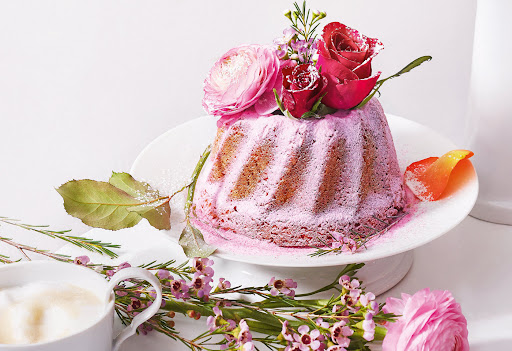
A beautiful Gugelhupf decorated with roses (Frisch Gekocht – in German)
Unfortunately, we can’t find many answers for exactly why the Guggelhupf had a hole in its centre, simply because of how old the cake is! Even though it first showed up as a recipe in the cookbook, Ein new Kuchbuch by Marx Rumpolt in Medieval Times, some people suspect it might’ve even been made in Ancient Rome. Linguists suggest the name comes from the Middle High German word “gugel” which meant “hood” or “hat.” There are also several references throughout history to a ring-shaped cake and its association with turbans, either as a sign of respect or defeat. For example, the Dutch Kersttulband cake, means “Christmas Turban”. Or even the bundkuchen means “tied cake” which many believe refers to a turban. The references to these cakes as headware have given way to a popular theory that the reason for the hole is that this cake was meant to signify a turban, hat, or crown.
What Makes Bundts Distinct?
There are so many cakes throughout the world with different names and the same shape. Although many of them may have distinctions (such as the yeast in Gugelhupf), Bundt cakes are far more generic than that. Predominantly it’s just the North American way of referring to any ring cake. There isn’t much else of a distinction. Some people insist that there is a specific way of making the Bundt, including with pound cakes, adorned with oranges, or with marbled vanilla and chocolate. But at its core, this cake has become through the years, more of an iconic shape made from any cake you want.
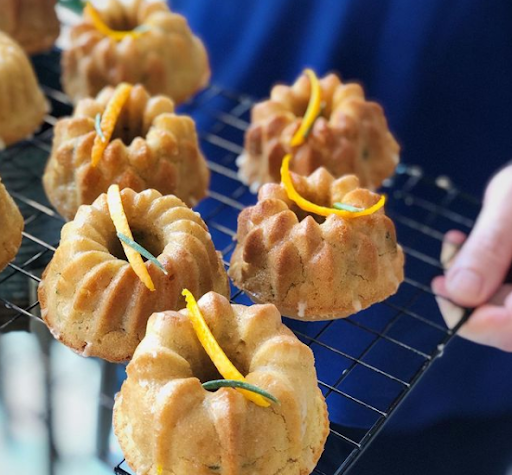
Triple Orange & Rosemary Mini Bundt
Because of how much easier it is to make pound cakes in Bundt pans, some people heavily associate the two cakes. Pound cakes do have a similarity to Bundt cakes in that they don’t refer to any particular recipe. Any cake that has a pound of each ingredient is a pound cake. The ingredients are usually flour, butter, eggs, and sugar, but not exclusively. But again, any cake can be a Bundt if you choose so . Except perhaps, the angel food cake… Did you know that angel food cakes are made in tube pans?
Bundt Pan VS. Tube Pan
Although a tube pan and a Bundt pan may look similar to the untrained eye, one is much better for baking angel food cakes, the tube pan. A tube pan is less fluted than a Bundt pan, meaning that the pan’s sides are more straight up and down. The tube pan also doesn’t have grooves or any decoration to the shape of the pan. This is for very specific reasons. The unequaled fluffy texture of an angel food cake is fragile in the baking stage as they don’t have leaveners like baking soda or yeast. The fluffiness needs the side of the pan to hold onto to properly rise. Thus, tube pans are even called angel food pans sometimes because of how great they are for angel food cake. So although they are both cake pans with holes in the centre, they are distinct and perfect for their separate reasons.
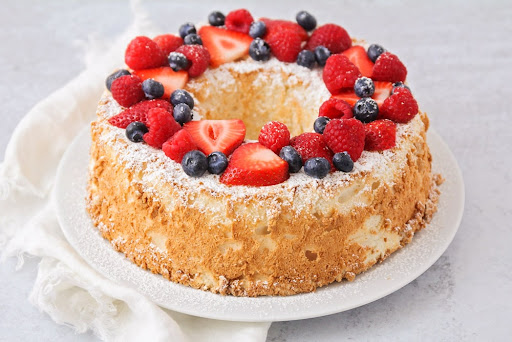
Angel Food Cake in all its circular glory (Lil’ Luna)
Why is Bundt Such a Christmas Favourite?
In Medieval times, the Gugelhupf was fundamental to holiday gatherings. It would be decorated with beautiful ornaments and candles in the centre, almost like a candle holder. But as we previously mentioned, this cake is also really easy to make and really easy to make look beautiful! Which is why it became so popular for such a busy and sometimes stressful and expensive holiday. There have also been many different Bundt pans throughout the years, with effortlessly intricate designs such as pine trees and wreaths. Tradition and ease have made this cake so popular!

A pine tree forest, easy and gorgeous for the holidays (Nordic Ware)
There is also a theory that the Three Wise Men (from the Gospel of Matthew and Christian tradition) were the ones to invent the Gugelhupf that the Bundt was inspired by. This theory is heavily held especially by the people from Alsace, France. They believe the Wise Men traveled to Alsace after visiting Jesus and stayed with a chef there. In gratitude, they invented a new kind of cake for him, which was the Gugelhupf (or Kugelhupf as they call it). If you ask someone from Austria (where this cake is also said to have been invented), they would probably not agree with this story. But either way, the association with the Wise Men has given the tradition of this circular dessert as a Christmas dessert a strong place at the Christmas table.
What are the Typical Christmas Bundt Cake Flavours?
Classic Vanilla
One of the most popular Bundt cakes for Christmas is the classic vanilla Bundt cake with dusted icing sugar. You really can’t argue with something that will appease a crowd!
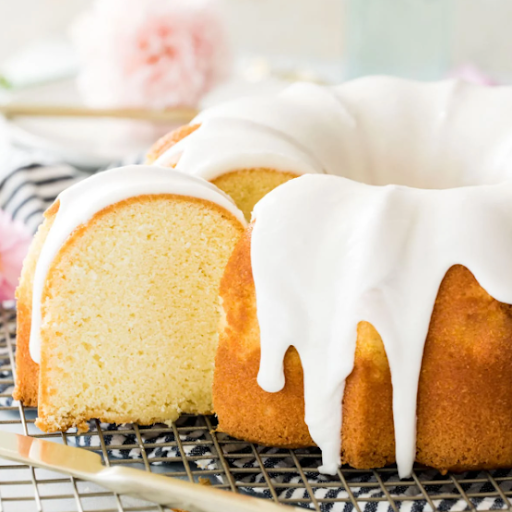
Vanilla with a simple icing (Sugar Spun Run)
Marbled
This one can be any two kinds of swirled ingredients. Chocolate and vanilla is of course very popular. But for the holidays, vanilla and red velvet can be gorgeous as well, if not just for the festive colours.
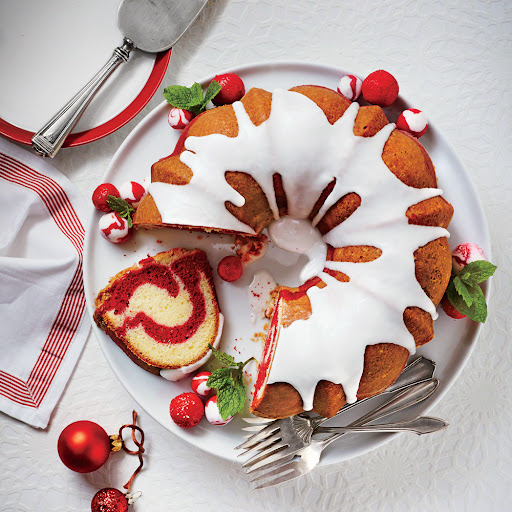
Red Velvet and Vanilla Swirl (Iain Bagwell from (My Recipes)
Cranberry Orange
A fresh and zesty mix of cranberry and orange Bundt cake topped with an orange zest glaze? Yes, please! Oranges are a very popular Christmas ingredient, from Saint Nicholas myths of putting them in stockings to stringing up dried oranges as decoration. And cranberries are especially popular for Christmas in Canada, the US, and the UK. Mixing them together is a match made in heaven!

Cranberry Orange Bundt with sugared cranberries (Tutti Dolci)
Rum
Rum cakes are classic Christmas black cakes that come from the Caribbean in the 18th century. Dried fruits are soaked in rum for months and then cooked with batter that contains caramelized sugar. Get a spin on these iconic cakes and put them in Bundt form!
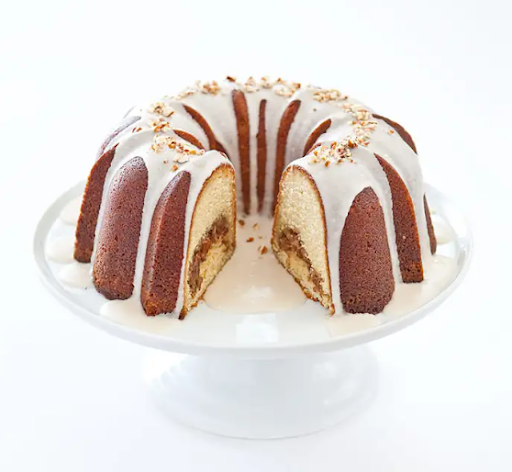
Holiday Rum Cake (America’s Test Kitchen)
Eggnog
Because the vanilla Bundt is so popular, you can get a bit of a seasonal spin with this creamy version. Have it with or without the brandy.
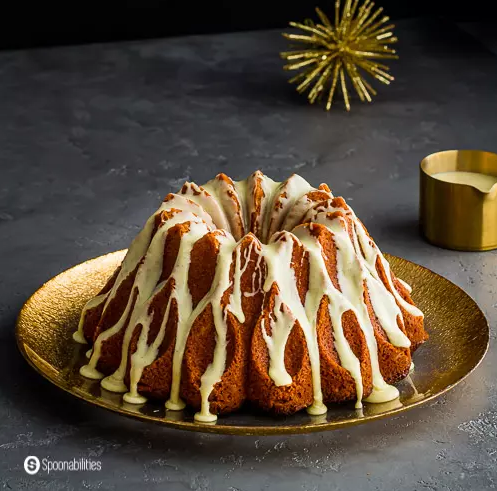
Brandy Eggnog Bundt Cake (Spoonabilities)
Peppermint Mocha
One of the most iconic Christmas tastes is peppermint candy cane. And mixing that with chocolate has become very popular, especially in coffee drinks throughout the years. Get all your favourite flavours in one circular shape!

Peppermint Mocha Bundt cake with a delicious glaze (Handle The Heat)
Spiced
The Christmas cake, or Spiced cake is a dessert that was inspired by the spices that the Three Wise Men brought for Jesus. This cake in the shape of a Bundt cake is the perfect Christmas dessert!
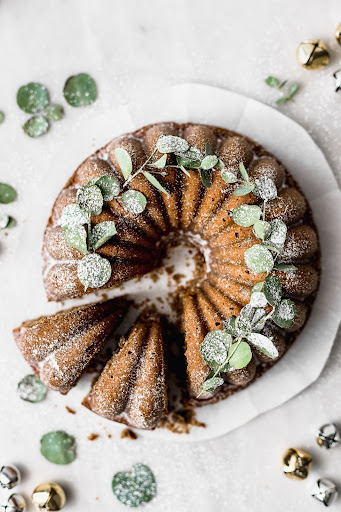
Christmas Spice Cake (Cravings Journal)
What Materials are the Bundt Pan Made of?
Now, if you go to Nordic Ware’s website, they’re very clear about what their Bundt pans are made of; either aluminum or cast aluminum. However, because of the popularity of this cake and pan, there are many “fluted tube pans” that borrow the shape. These can be made from many materials such as aluminum, carbon steel, stainless steel, cast iron, or even silicone. The original Gugelhupf pan was generally made out of ceramic, which is also still used to this day.
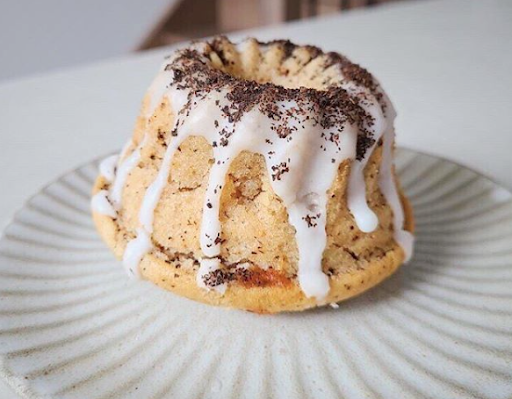
Earl Grey and Orange Blossum Bundt
What Makes Bakeware Sustainable/Eco-friendly?
Bakeware has a bit of a controversial debate around it concerning sustainability and health. Because of its persistent proximity to heat, whatever material it’s made out of is prone to breaking down. It’s really in this breaking down that health can become a concern. And in the manufacturing process and once it’s broken down completely and needs to be thrown out is when concerns for the environment begin.
Non-stick metal is certainly at the centre of this debate since the concerns regarding Teflon, which is what famously coats many of these pans to create that easy non-stick, took the world stage around 2013. The most concrete issues are the use of dangerous synthetic chemicals called PFAS (Perfluoroalkyl and Polyfluoroalkyl Substances) which are known as “forever chemicals”. They do not break down in the environment and early research suggests links to terminal illness such as cancer.
While the particular chemical was phased out of use once its dangers became known, and the company responsible settled with many of the people affected, there is still concern that when you heat the new non-stick chemical, Fluoropolymer, over 500° Fahrenheit, it may have negative effects including decreased fertility in humans and animals and even cancer. Furthermore, when it gets into the environment through air and waterways the concern is that wildlife and biodiversity will irreparably be affected. Although non-stick pans are seen as safe to use today, these chemicals don’t break down and this is where the controversy lies. Some people are very happy with their non-sticks, and some prefer going back to older methods, such as ceramic or cast iron.
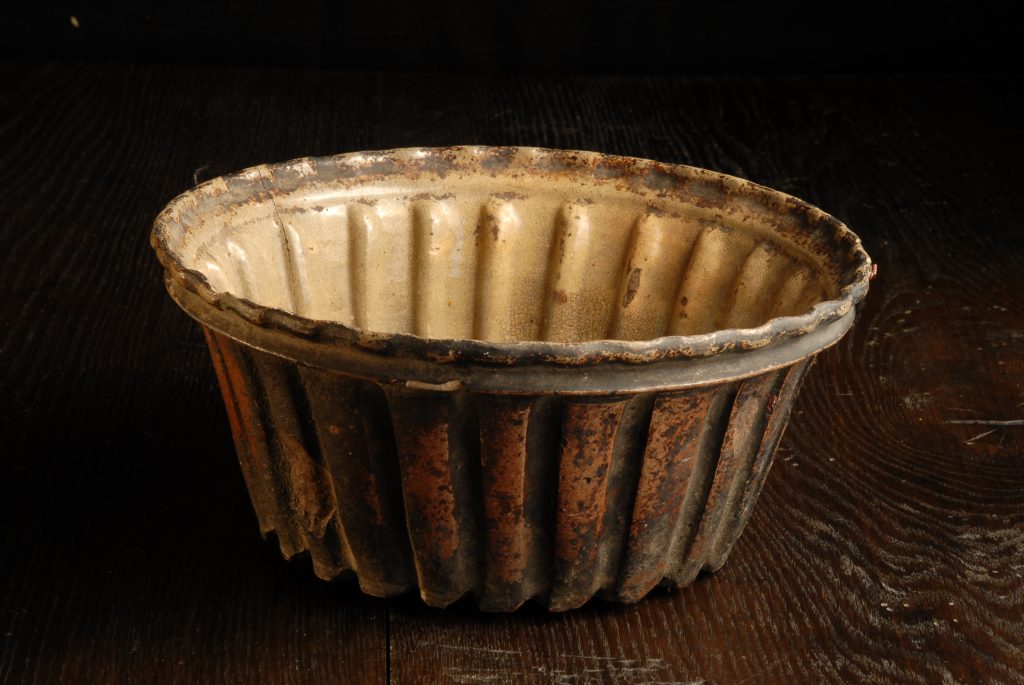
An old clay Bundt pan
When looking at the sustainability of bakeware, it’s important to think about the product itself and what it’s made up of, but it’s also important to look at the life cycle of the product. The manufacturing process, with its energy use, waste, and carbon emissions in general can be the worst part of a product’s effect on the environment. To minimize this effect, one of the most important aspects to consider regarding sustainable bakeware is durability. If you can find a product that will last a long time, and you won’t have to dispose of and replace it, you can reduce your bakeware impact.
Follow your heart when it comes to choosing bundt bakeware. These beautiful and historical cakes represent the gathering of people and the importance of baking as an art. Plus, these cakes taste SO good. You can use Dessert Advisor’s dessert searching tool to find Bundt cakes near you if you’re craving some. Join the celebration!





